Menus
- All against the new GS
- All against the new GS
- Braking stability remains unmatched
- The engines of the competitors
- The competitors in detail
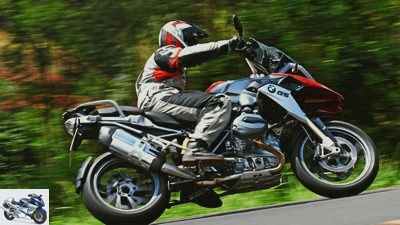
Alschner
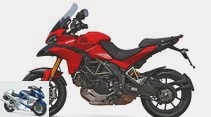
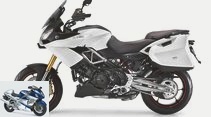
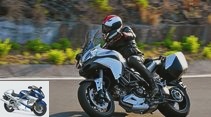
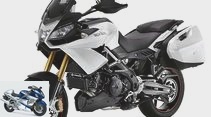
36 photos
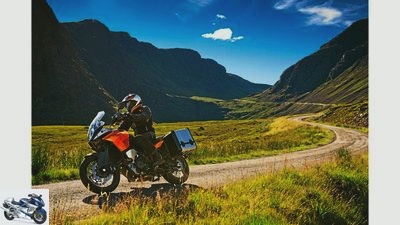
Schedl
1/36
KTM 1190 Adventure
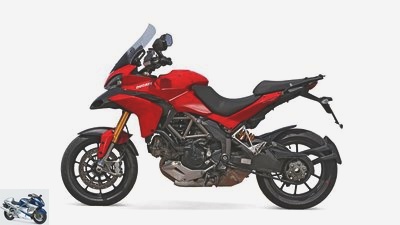
Manufacturer
2/36
Ducati Multistrada 1200: two-cylinder 90-degree V-engine, chain, power: 148 hp, displacement: 1198 cm3, weight: 232 kg, price: from 15 490 euros; low weight, electronically adjustable driving modes, ABS, TCS including suspension adjustment, very sporty, powerful engine, robust, especially expensive with additional equipment, rough engine, somewhat high consumption.
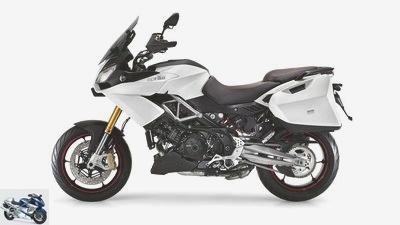
Manufacturer
3/36
Aprilia Caponord 1200: two-cylinder 90-degree V-engine, chain, power: 128 hp, displacement: 1197 cm3, weight: approx. 250 kg, price: from 13500 euros; electronically adjustable driving modes including chassis adjustment, high-torque motor, especially with additional equipment, significantly more expensive, not particularly economical
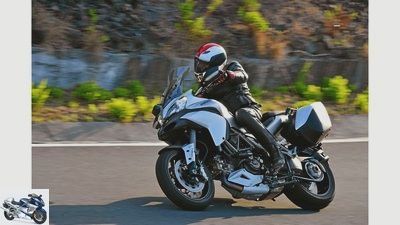
Manufacturer
4/36
Ducati Multistrada 1200
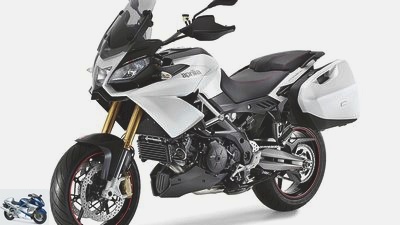
Manufacturer
5/36
Aprilia caponord 1200
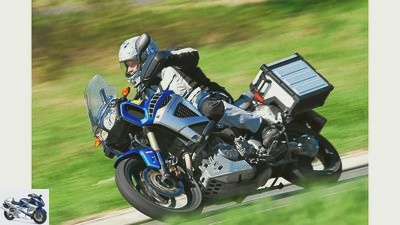
Artist
6/36
Yamaha XT 1200 Z Super Tenere

7/36
Honda Crosstourer
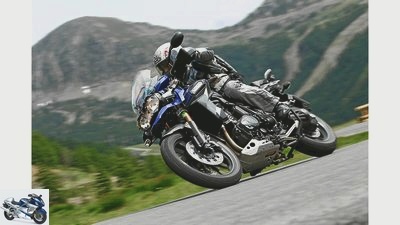
Gargolov
8/36
Triumph Tiger Explorer

Gargolov
9/36
Kawasaki Versys 1000

Gargolov
10/36
Moto Guzzi Stelvio 1200 8V
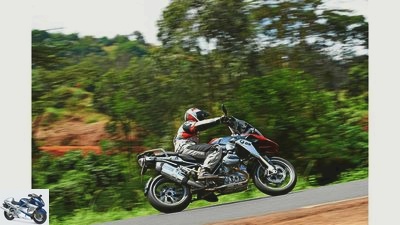
Alschner
11/36
BMW R 1200 GS
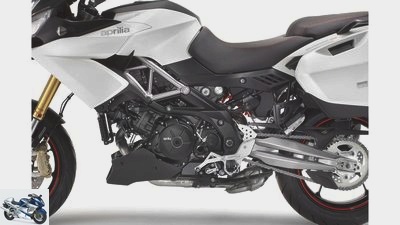
Manufacturer
12/36
Aprilia Caponord 1200: slim V2 with a lot of pressure, but so far high consumption.
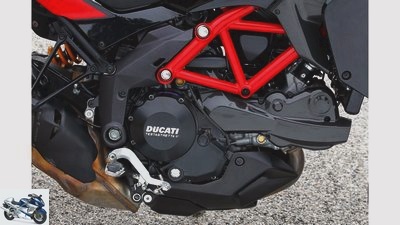
13/36
Ducati Multistrada 1200: astonishingly robust Desmo – wild, strong, exciting.

14/36
Honda Crosstourer: V4 steam hammer, robust, with automatic DCT on request.

15/36
Kawasaki Versys 1000: row fours trimmed for pulling through, classic Japanese.
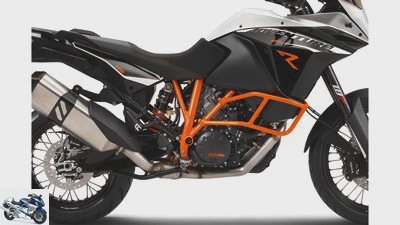
Manufacturer
16/36
KTM 1190 Adventure: extremely powerful V2, gentler than running in an athlete, great.

Manufacturer
17/36
BMW R 1200 GS: completely new, water-cooled boxer with air-cooling optics, now vertical flow and less centrifugal mass. Powerful and spirited.
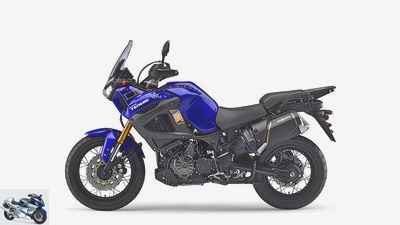
Manufacturer
18/36
Yamaha XT 1200 Z Super Tenere two-cylinder in-line engine, cardan shaft, power: 110 hp, displacement: 1199 cm3, weight: 267 kg, price: from 13 995 euros. Chassis: excellent comfort for driver and passenger; crisp brakes, low-reaction cardan motor looks a bit tough, high weight.
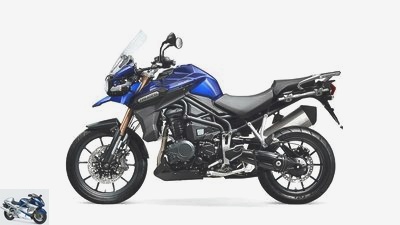
Manufacturer
19/36
Triumph Tiger Explorer: three-cylinder in-line engine, cardan shaft, power: 137 hp, displacement: 1215 cm3, weight: 275 kg, price: from 13790 euros; great three-cylinder sound, paired with plenty of power from the lower speed range, stable and durable motorcycle, ABS and slip control as standard, moderate seat height, heavy, suspension not perfectly coordinated.
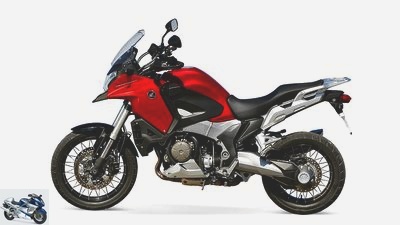
Manufacturer
20/36
Honda Crosstourer: four-cylinder V-engine, cardan, power: 129 hp, displacement: 1237 cm3, weight: 275 kg, price: 13490 euros; exceptionally powerful engine, extensive standard equipment, e.g. B. ABS and traction control, DCT possible, high driving and travel comfort, good pillion suitability, very heavy, poorly shaped handlebars.

Manufacturer
21/36
Moto Guzzi Stelvio 1200 8V: two-cylinder V-engine, cardan shaft, power: 105 hp, displacement: 1151 cm3, weight: 285 kg, price: 14 290 euros; Excellent wind protection, rich standard equipment, long range, snappy brakes with good stability, pulling values for the weight still okay, very heavy, sensitive to falls.
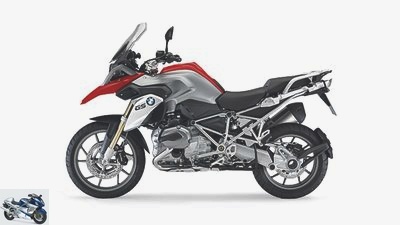
Manufacturer
22/36
BMW R 1200 GS: two-cylinder boxer engine, cardan shaft, power: 125 hp, displacement: 1199 cm3, weight: 238 kg, price: 14,100 euros; Full electronics program, new, easy-revving motor with a robust sound, crisp brakes, low-reaction cardan, still low weight.
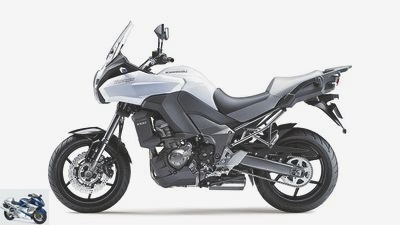
Manufacturer
23/36
Kawasaki Versys 1000: four-cylinder in-line engine, chain, power: 118 hp, displacement: 1143 cm3, weight: 239 kg, price: 11,995 euros; Full torque even at low speeds, well balanced, very good handling, high payload, low price, some details carelessly executed, design takes getting used to.
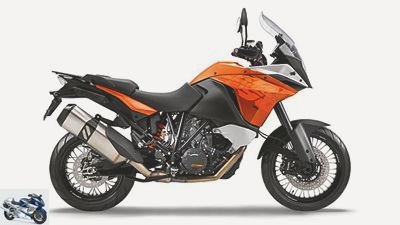
Manufacturer
24/36
KTM 1190 Adventure: two-cylinder 75-degree V-engine, chain, power: 150 hp, displacement: 1199 cm3, weight: 240 kg, price: from 13990 euros; large safety package with ABS and TCS, beefy engine characteristics and high performance, good handling, off-road capability, well thought-out overall concept, rough engine running at higher speeds.

25/36
Overall: 1st KTM 1190 Adventure; 2. Ducati Multistrada 1200; 3. BMW R 1200 GS; 3. Triumph Tiger Explorer; 5. Kawasaki Versys 1000; April 5, Caponord 1200; 7. Honda Crosstourer; 8. Yamaha XT 1200 Z Super Tenere; 9. Moto Guzzi Stelvio 1200 8V
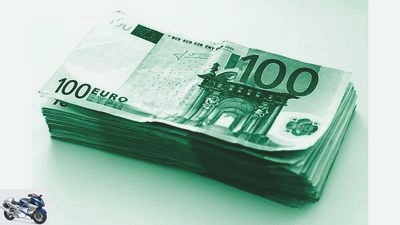
fotolia
26/36
1. Kawasaki Versys 1000 11,995 euros; 2. Honda Crosstourer 13,490 euros; 3. Aprilia Caponord 1200 13,500 euros; 4. Triumph Tiger Explorer 13 790 euros; 5. KTM 1190 Adventure 13,990 euros; 6. Yamaha XT 1200 Z Super Tenere 13,995 euros; 7. BMW R 1200 GS 14,100 euros; 8. Moto Guzzi Stelvio 1200 8V 14,290 euros; 9. Ducati Multistrada 1200 15,490 euros
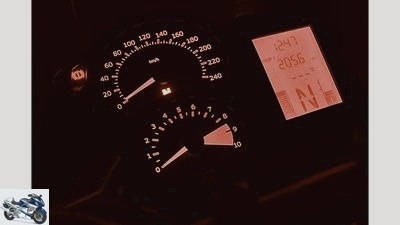
27/36
Equipment: 1. BMW R 1200 GS LED daytime running lights, on-board computer, wind protection, seat height, many special accessories; 2. Triumph Tiger Explorer cardan shaft, cruise control, seat height, wind protection, tire pressure, on-board computer, many special accessories; 3. Ducati Multistrada 1200 LED daytime running lights, on-board computer, wind protection, lots of special accessories; 4. KTM 1190 Adventure LED daytime running lights, on-board computer, seat height, wind protection, lots of special accessories; 5. Aprilia Caponord 1200 cruise control, LED daytime running lights, on-board computer, lots of special accessories; 6. Honda Crosstourer cardan, on-board computer, wind protection, many special accessories; 7. Yamaha XT 1200 Z Super Tenere cardan, on-board computer, windscreen; 8. Kawasaki Versys 1000 on-board computer, windscreen; 9. Moto Guzzi Stelvio 1200 8V cardan, on-board computer, windscreen
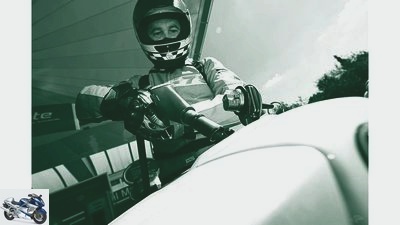
Artist
28/36
Range: 1. Moto Guzzi Stelvio 1200 8V approx. 600 km; 2. Yamaha XT 1200 Z Super Tenere 450 km; 3. KTM 1190 Adventure 430 km; 4. Kawasaki Versys 1000 420 km; 4. Triumph Tiger Explorer 420 km; 6. Honda Crosstourer 400 km; 7. BMW R 1200 GS 380 km; 7th Aprilia Caponord 1200 380 km; 9. Ducati Multistrada 1200 360 km
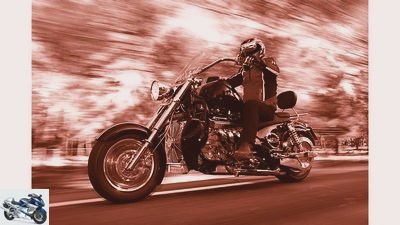
Artist
29/36
Weight: 1. Ducati Multistrada 1200 229 kg; 2. KTM 1190 Adventure 230 kg; 3. BMW R 1200 GS 238 kg; 4. Kawasaki Versys 1000 241 kg; 5th Aprilia Caponord 1200 250 kg; 6. Yamaha XT 1200 Z Super Tenere 267 kg; 7. Triumph Tiger Explorer 275 kg; 8. Honda Crosstourer 283 kg; 9. Moto Guzzi Stelvio 1200 8V 291 kg
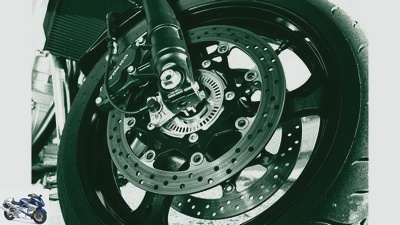
30/36
Assistance systems: 1) BMW R 1200 GS; 2) Ducati Multistrada 1200; 3) KTM 1190 Adventure; 4) Aprilia Caponord; 5) Triumph Tiger Explorer; 6) Honda Crosstourer; 7) Yamaha XT 1200 Z Super Tenere; 8) Kawasaki Versys 1000; 9) Moto Guzzi Stelvio 1200 8V
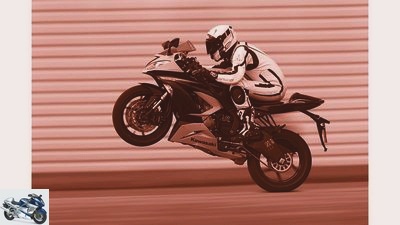
31/36
Performance: 1. Ducati Multistrada 1200 vmax 245 km / h Acceleration 0-200 10.1 sec, pulling 60-140 8.4 sec; 2. KTM 1190 Adventure vmax240 km / h acceleration 0-200 approx. 10.5 sec, pulling 60-140 approx. 8.1 sec; 3. Kawasaki Versys 1000 vmax226 km / h Acceleration 0-200 12.4 sec, pulling 60-140 7.7 sec; 4. Triumph Tiger Explorer vmax215 km / h, acceleration 0-200 12.0 sec, pulling 60-140 8.1 sec; 5. BMW R 1200 GS vmax220 km / h, acceleration 0-200 12.5 sec, pulling 60-140 approx. 7.8 sec; 6. Aprilia Caponord 1200 vmax210 km / h, acceleration 0-200 12.5 sec, pulling 60-140 8.0 sec; 7. Honda Crosstourer vmax209 km / h Acceleration 0-200 14.3 sec, pulling 60-140 8.6 sec; 8. Moto Guzzi Stelvio 1200 8V vmax220 km / h Acceleration 0-200 18.1 sec, pulling 60-140 9.8 sec; 9. Yamaha XT 1200 Z Super Tenere vmax210 km / h Acceleration 0-200 22.6 sec, pulling 60-140 9.7 sec
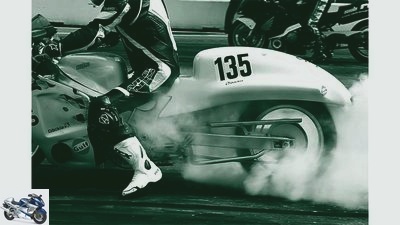
32/36
Engine output: 1. KTM 1190 Adventure 110 kW (150 PS) at 10,000 rpm; 2. Ducati Multistrada 1200 109 kW (148 PS) at 9250 / min, 125 Nm at 7500 / min; 3. Triumph Tiger Explorer 101 kW (137 PS) at 9000 rpm, 121 Nm at 6400 rpm; 4. Honda Crosstourer 95 kW (129 PS) at 7750 rpm, 126 Nm at 6500 rpm; 5. Aprilia Caponord 1200 94 kW (128 PS) at 8500 rpm, 120 Nm at 6500 rpm; 6. BMW R 1200 GS 92 kW (125 PS) at 7700 rpm, 125 Nm at 6500 rpm; 7. Kawasaki Versys 1000 87 kW (118 hp) at 9000 rpm, 102 Nm at 7700 rpm; 8. Yamaha XT 1200 Z Super Tenere 81 kW (110 PS) at 7250 rpm, 114 Nm at 6000 rpm; 9. Moto Guzzi Stelvio 1200 8V 77 kW (105 PS) at 7250 rpm, 113 Nm at 5800 rpm
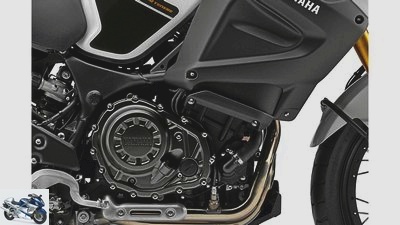
33/36
Yamaha XT 1200 Z Super Tenere: gentle companion, does not cause stress, indestructible.
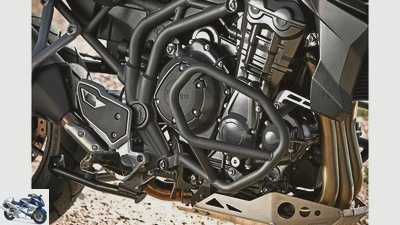
34/36
Triumph Tiger Explorer: tractor triplet, pulls from idle, pressure in every position.
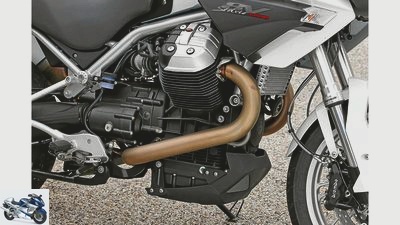
35/36
Moto Guzzi Stelvio 1200 8V: real Guzzi-V2, pounding, thundering and quite fast.
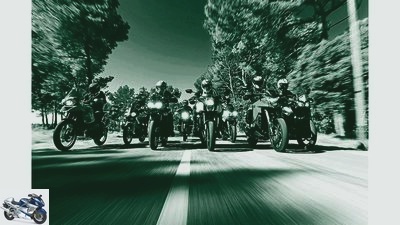
36/36
Many values are still based on factory information or, in the case of KTM and Aprilia, on estimates. The tests will follow from March.
Positioning the BMW R 1200 GS
All against the new GS
With the completely redesigned R 1200 GS, BMW will hit the market at the end of February. The boxer has never met such tough competition. At least eight opponents are already waiting for the travel enduro or are about to start. What are the chances of the GS?
All against the new GS
E.It had to happen at some point. For years, competitors watched as the BMW GS became increasingly popular. Even when the bearish boxer became the world’s best-selling motorcycle over 600 cm3 years ago, the big manufacturers seemed to be sleeping peacefully. But maybe they just waited for BMW to announce a model change in order to counter this all the more. Bringing the successor to a bestseller is always a risk. Especially when, like BMW, you also fundamentally change the technology. And it is precisely into this possible phase of weakness that a lot of brands are targeting.
Buy complete article
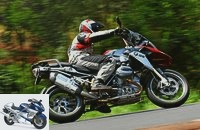
Positioning the BMW R 1200 GS
All against the new GS
Kawasaki Versys 1000 and the Yamaha Super Tenere. And the Triumph Explorer with its powerful three-cylinder engine offers more smooth running than a current GS. So it could be tight for the new GS.
Manufacturer
How does the BMW R 1200 GS compare to the competition??
It is therefore astonishing, for example, that BMW with "just" 125 PS competes against the sometimes much stronger competition. Of course, the horses on offer are sufficient in almost every situation. But with this performance, the BMW is now on the weaker side and only ranks ahead of Moto Guzzi, Yamaha and Kawasaki. It is clearly beaten by Ducati, KTM and Triumph; the Honda Crosstourer with its magnificent V4 engine and the Aprilia are slightly above it. In terms of torque, the new boxer seems to be hard to beat, 125 Nm is a top value.
The low-maintenance cardan drive is no longer unique. Here Triumph, Yamaha and Honda have long since drawn level. And, the Munich-based company has to admit, despite simpler constructions with good results. The subject of driving safety is also no longer a domain of Munich technology, despite off-road ABS from Conti. Here the new KTM Adventure with Bosch off-road ABS and TCS will at least be able to keep up, the revised Ducati Multistrada also offers top technology in terms of safety with off-road ABS and the finest slip control. The world’s largest automotive supplier has now discovered the motorcycle business and of course wants to equip as many manufacturers as possible. Compared to before, BMW no longer has any advantage over the competition.
How much the Munich-based company has to step on the gas in the meantime can be seen from another supplier section. The MOTORRAD team was very surprised when the Ducati Multistrada 1200 endurance test machine was dismantled. The clutch, which incidentally put away 50,000 kilometers without complaint, looked very familiar to us. The part built by the Japanese supplier FCC resembles the new boxer clutch. Except that Ducati has been using it for three years.
And what about in terms of weight? Here, too, the BMW will face equal opponents. Because the GS didn’t get any easier. Despite the new engine and chassis, the Munich-based woman put on a few pounds, the water cooling just pays for the weight account. How much exactly is what the incorruptible MOTORRAD scales have to show during the first test. Ducati and KTM are almost certainly built much lighter, but the new GS is by far the lightest cardan motorcycle
among the travel enduros.
Braking stability remains unmatched
Alschner
BMW R 1200 GS: Completely new, water-cooled boxer with air-cooling optics, now vertical flow and less flywheel. Powerful and spirited.
So far, the chassis properties of the GS have always been outstanding. Thanks to Telelever and electronically adjustable springs and dampers, they were miles ahead of the competition. The braking stability of the BMW construction with the trailing arm flanged to the engine is and remains unmatched. Even the best telescopic fork is left behind here. In terms of electronic chassis, however, some brands have caught up. Ducati supplies the full range with four riding modes that also influence springs and dampers. KTM and Aprilia are going in the same direction. There is still nothing from Japan. And the Guzzi can be regarded as technically more oriented towards the old GS anyway.
So: Technically, the BMW can by no means set itself apart from the competition. But how does it look conceptually? And how much does the image of the GS play a role? One thing is clear: no other motorcycle stands for a whole genre of machines like the GS for travel enduro bikes. 170,000 machines built, tens of thousands of satisfied customers, many millions of enjoyable kilometers driven, that’s a bank. The newcomers from Aprilia, Ducati, Triumph, Kawasaki and Honda have a hard time because they first have to generate interest. Only the Yamaha Super Tenere and the KTM Adventure can fall back on a previous model. And that of the Yamaha is almost historical. Here the pleasant model constancy of the Munich-based company offers an unbeatable advantage.
And what BMW has been cultivating for a long time: As a GS rider, you are a member of the GS world. What Harley-Davidson has created with the friends of chopper culture over the years can certainly be said of BMW at the GS. It starts with the GS-look driver’s suits and does not end with the GS Challenge sporting event. Numerous world travelers were also equipped with GS machines and thus perfect product placement was created. Just think of the photographer Michael Martin and his fascinating pictures. It goes without saying that the man needs a GS to get through the deserts of the earth. The idea of the BMW Enduro Park in Hechlingen was also brilliant. Here the Munich-based company created a real Mecca for off-road enthusiasts with little effort. Which manufacturer has been making such an effort for decades to offer its customers something very special?
BMW
But let’s still talk about the conception and thus also about the optics. Here, too, BMW sets the standard. When the first Entenschnabel GS hit the market in 1994, there was a lot of noise. Today almost everyone has beaks or similar appendages. The aerodynamic advantage is undisputed.
The single-sided swing arm and the narrow, high-lying muffler were also adopted from many current machines. The Bavarians were the first to be on the market. So with the GS you somehow buy the original. So it’s good that the new one is the same as the old one. From a purely conceptual point of view, little has been changed in the new GS. What remains is the boxer engine, single-sided swing arm, cardan drive, Telelever, tubular steel frame rear and the comfortable two-part seat. And with it this robust configuration of a travel enduro, which has been tried and tested thousands of times, which can also fall over while standing, without having to pay a hefty sum for fall parts. The two water coolers were hidden so cunningly that you can’t even get the idea that the BMW is more vulnerable than before.
The others can’t keep up with that. With the exception of the KTM, the competition’s cruise ships are more likely to be damaged in the worst-case scenario. A lot of crash bars have to help. With Triumph, Honda, Ducati and Moto Guzzi, only experts should take hearty gravel under their wheels anyway. Somehow the Ducati is too good and the others are just too heavy. The KTM Adventure is the only one to be available in a 21-inch front-wheel version that should also be able to handle bigger things. What remains? The character. The rumbling of the Guzzi V2, the three-cylinder steam hammer of the Triumph, the Honda V4 bull, which is even available with a DCT automatic – all great long-distance engines. The pulling miracle Kawasaki, the (hopefully) powerful Aprilia and the gentle and indestructible Yamaha also offer a lot for the mind.
Manufacturer
The engine of the BMW R 1200 GS in section: Among other things, you can see the oil bath clutch and the slightly curved inlet duct.
We recommend the Ducati and KTM to wild boys (and girls), whose V2 engines come straight from street racing. And the new boxer? The author has already been allowed to turn the gas a few times. The new engine is much more spontaneous on the gas, revs up really willingly and runs more smoothly. He has a lot to offer in terms of sound. Our tests have to show whether it also has this ox character of the old air-cooled one. Until then we tried to create a first picture with the above table. It is of course still quite sketchy, because some data are based on factory information or even had to be accepted. And there are still no driving impressions from the BMW anyway. So, dear readers: Don’t take the rating so seriously.
Conclusion
The first assessment predicts a tight result. And the driving characteristics could not be incorporated at all anyway. It already seems clear today: The new GS faces significantly stronger competition, which is even ahead in individual areas. There is one thing that the BMW is absolutely unbeatable: it remains the lightest cardan enduro. And in terms of equipment and special accessories, you can hardly lead anyone else. exciting.
The engines of the competitors
BILLION
The boxer engine of the BMW R 1200 GS impresses with high torque, but lags behind in terms of top performance.
Attention: In order to give a first impression, the factory specifications of BMW and Aprilia are used and compared with curves measured by MOTORRAD. The new boxer engine impresses with its high torque. In terms of top performance, he tends to lag behind. Unfortunately, KTM MOTORRAD did not want to deliver a performance curve for the new 1190 Adventure yet, it seems that they have not yet received a homologation. Beating the Ducati Multistrada should be difficult for the KTM. Triumph-Drilling, Aprilia-V2 and Honda-V4 form a league, the in-line four-cylinder of the Kawasaki turns at its highest with its displacement shortage. The Yamaha and Moto Guzzi are more on the tame side.
BMW R 1200 GS: completely new, water-cooled boxer with air-cooling optics, now vertical flow and less flywheel. Powerful and spirited.
Aprilia Caponord 1200: slim V2 with a lot of pressure, but so far high consumption.
Ducati Multistrada 1200: amazingly robust Desmo – wild, strong, exciting.
Honda Crosstourer: Steam hammer V4, robust, with automatic DCT on request.
Kawasaki Versys 1000: Row fours trimmed to pull through, classic Japanese.
KTM 1190 Adventure: extremely powerful V2, gentler than running in an athlete, top.
Moto Guzzi Stelvio 1200 8V: real Guzzi-V2, stamping, thundering and quite fast.
Triumph Tiger Explorer: Tractor triplet, pulls from idle, pressure in every position.
Yamaha XT 1200 Z Super Tenere: gentle companion, does not cause stress, indestructible.
The competitors in detail
Alschner
A close look – the handlebars of the BMW R 1200 GS.
BMW R 1200 GS
Two-cylinder boxer engine, cardan, power: 125 hp, displacement: 1199 cm3, weight: 238 kg, price: 14,100 euros.
+ full electronics program
+ new, easy-revving motor with a robust sound
+ crisp brakes
+ low-reaction cardan
+ still light weight
Aprilia caponord 1200
Two-cylinder 90-degree V-engine, chain, power: 128 hp, displacement: 1197 cm3, weight: approx. 250 kg, price: from 13500 euros.
+ Electronically adjustable driving modes including suspension adjustment for a surcharge
+ high-torque motor
– significantly more expensive, especially with additional equipment
– not particularly economical
Ducati Multistrada 1200
Two-cylinder 90-degree V-engine, chain, power: 148 hp, displacement: 1198 cm3, weight: 232 kg, price: from 15,490 euros.
+ light weight
+ electronically adjustable driving modes, ABS, TCS including chassis adjustment
+ very sporty, powerful engine
+ robust
– especially expensive with additional equipment
– gruff engine, somewhat high consumption
Honda Crosstourer
Four-cylinder V-engine, cardan, power: 129 hp, displacement: 1237 cm3, weight: 275 kg, price: 13490 euros.
+ exceptionally powerful engine
+ extensive standard equipment, e.g. B. ABS and traction control
+ DCT possible
+ high driving and travel comfort
+ good pillion suitability
– very difficult
– poorly shaped handlebars
Moto Guzzi Stelvio 1200 8V
Two-cylinder V-engine, cardan, power: 105 hp, displacement: 1151 cm3, weight: 285 kg, price: 14,290 euros.
+ excellent wind protection
+ rich standard equipment
+ great coverage
+ snappy brakes with good stability
+ Pull-through values for the weight are still okay
– very difficult
– sensitive to falls
Kawasaki Versys 1000
Four-cylinder in-line engine, chain, power: 118 hp, displacement: 1143 cm3, weight: 239 kg, price: 11,995 euros.
+ full torque even at low speeds
+ well balanced, very good handling
+ high payload
+ low price
– some details are carelessly executed
– Design takes getting used to
KTM 1190 Adventure
Two-cylinder 75-degree V-engine, chain, power: 150 hp, displacement: 1199 cm3, weight: 240 kg, price: from 13990 euros.
+ large safety package with ABS and TCS
+ beefy engine characteristics and high performance
+ good handling
+ all-terrain
+ well thought-out overall concept
– rough engine running at higher speeds
Triumph Tiger Explorer
Three-cylinder in-line engine, cardan, power: 137 hp, displacement: 1215 cm3, weight: 275 kg, price: from 13790 euros.
+ great three-cylinder sound, paired with plenty of power from the lower speed range
+ stable and durable motorcycle
+ ABS and slip control as standard
+ moderate seat height
– heavy
– Suspension not perfectly matched
Yamaha XT 1200 Z Super Tenere
Two-cylinder in-line engine, cardan, power: 110 hp, displacement: 1199 cm3, weight: 267 kg, price: from 13,995 euros.
+ Suspension excellent
+ a lot of comfort for the driver and passenger
+ crisp brakes
+ low-reaction cardan
– Motor seems a bit tough
– high weight
Related articles
-
Ducati Multistrada 1200, Kawasaki Versys 1000 and Triumph Tiger 1050 in the test
Gargolov Funbikes in comparison test Ducati Multistrada 1200, Kawasaki Versys 1000 and Triumph Tiger 1050 With bag and pack on a big tour or simply …
-
BMW 17 pictures Manufacturer 1/17 For more than 30 years, the BMW R 1200 GS has stood for all-rounders, alpine robbers and angasers, and as a clearing year has been booked for …
-
The enduro mega test: travel enduros up to 1200 cm³
44 pictures 1/44 The final opponent of BMW, the Triumph Tiger 800 XC. 2/44 Wide handlebars, fat motors, big …
-
Jahn 34 Pictures Jahn 1/34 Jahn 2/34 Lonely: The KTM is the only one of the Adventure Enduros to stay with chain drives. Light, but in need of care. Jahn 3/34 …
-
Top test: Yamaha XT 1200 Z Super Tenere
Bilski 23 pictures Yamaha 1/23 The wheel speed sensors for ABS and traction control receive their signals from radially attached rings. Yamaha …
-
39 pictures 1/39 The Triumph Speed Triple: The price 11,740 euros (the test motorcycle with windshield for 245 euros and …
-
Top test: Ducati Multistrada 1200 S Touring
28 pictures 1/28 In a total of four speed levels – Sport, Touring, Urban and Enduro – bits and bytes vary the chassis and …
-
BMW R 1200 GS and BMW R 1200 GS Adventure put to the test
Markus Jahn 34 pictures Jahn 1/34 Jahn 2/34 Jahn 3/34 Jahn 4/34 Jahn 5/34 Jahn 6/34 Jahn 7/34 Jahn 8/34 Jahn 9/34 Jahn 10/34 Jahn 11/34 Jahn 12 / 34 years …
-
Bilski Test Moto Guzzi Norge 1200 GT Velvet instead of special With the Norge, Moto Guzzi finally says goodbye to the image of the coarse racing cars….
-
Honda VFR 800 F and Honda VFR 1200 F in comparison test
fact 8 pictures fact 1/8 Clear distance: the two V4 engines always separate between 35 and over 50 Newton meters. fact 2/8 Honda built the first …